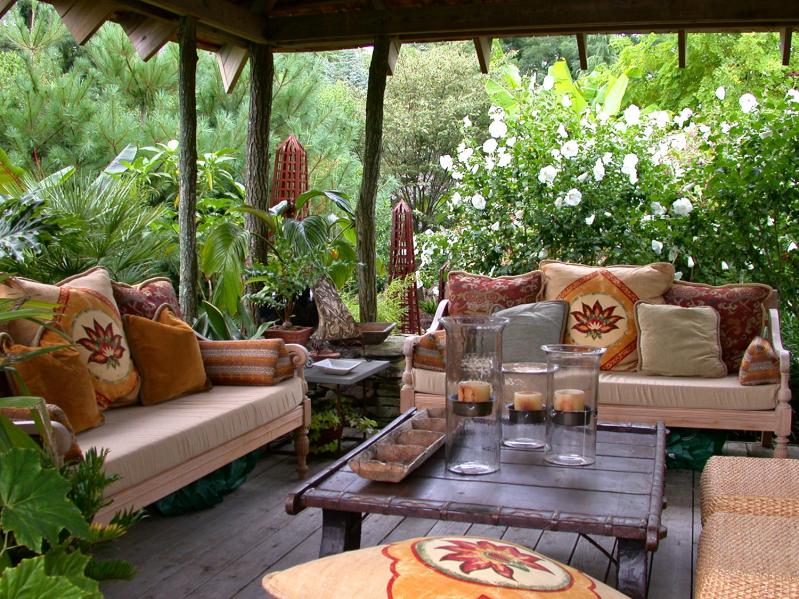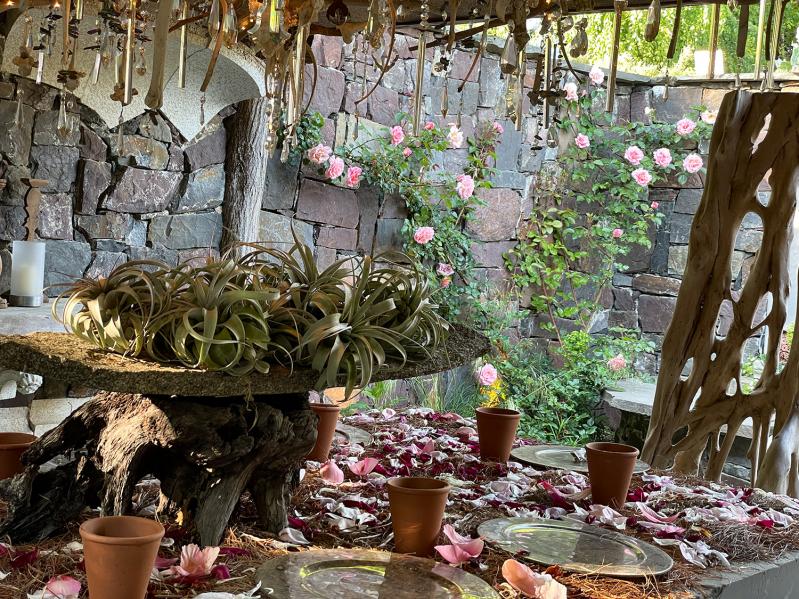Let us introduce you to the Landcraft Garden Foundation, the North Fork’s fraternal obverse to Jack Lenor Larsen’s LongHouse Reserve and a paradise that Dennis Schrader and Bill Smith have been building on the North Fork since 1992.
For this expert décor dream team — Mr. Schrader and Mr. Smith can transmute one’s terrain as fabulously as they can fancy one’s foyer — the early ’90s were as heart-rending a time as they were for New York at large. As the AIDS epidemic raged, the couple with seemingly endless social opportunities began to lose friends.
“We had this big posse of 50 to 80 people that would just roam from the beach to the parties to the scenes,” Mr. Schrader said of living the never-sleeping lifestyle for which the city is famously known. “Probably half that group — or more — are gone now.”

It’s the type of tragic that forces one to reflect upon mortality, but Mr. Schrader and Mr. Smith, like the textile muse Larsen, are the type of people who spin straw into gold. “It was all just more motivation to come out here and do this,” Mr. Smith said of transforming four of 17 acres of Mattituck farmland into a biodiverse legacy garden and nursery. In addition to being a hub for horticultural, musical, and artistic events, it has also grown veggies to feed folks through Slow Food East End.
There are seed pods of the Amorphophallus, Alluaudia from Madagascar, a monkey puzzle Araucaria from Chile, and orchids from around the world. There’s the “white ghost” Euphorbia lactea, the procera with its peeling bark, the Bombax and Cycads that predate dinosaurs. There’s even cosmic flare Gomphrena, a unique globe amaranth that was not only bred in the Landcraft nursery, but is now also patented and sold in garden centers across the world.
When Mr. Schrader says he has had a plant in his hand since his sandbox days, one may think he’s kidding. He is not.
“I would be late to school, or coming home, because I would be redesigning gardens in my mind as I walked past the houses. I would always be thinking, ‘If this tree were over there it would look better’ . . . and that never went away. I always loved being in a garden or outside building things out of dirt and sticks.”
A Subterranean Ruin for a Ritual
Move over, dirt and sticks — enter deer bones and broken pots brought together with ballast from across Europe and the United States, used by Mr. Schrader and Mr. Smith to build a subterranean ruin right into their backyard, complete with a chandelier concocted from a deer skeleton they found in their fields.
“We basically built a house foundation and started adding all the details from things I had,” Mr. Schrader said of stuff he has collected throughout his professional journey. Among this are eight pallets of an entire building he once accidentally bought at auction for $450. There are also actual castle pieces, including some from the publishing tycoon William Randolph Hearst’s historic San Simeon landmark in California, as well as the neo-Gothic Belmont Castle in Essex County, England, which was knocked down in the 1940s.
Coupling that with the mere existence of the deer-bone chandelier hanging over the ruin’s handmade central feasting table, chairs, and accouterments fit for kings of kings, makes it obvious that Mr. Schrader is a person who has wasted little in life, making so much of whatever he is given. One cannot help but notice the attention paid to every square inch of the Landcraft universe. There are even shards of broken terra cotta filling spaces between stones as if extrapolating the art of Kintsugi, a 16th-century method of repairing ceramics with gold seams, with cracks joined together by brokenness itself rather than by liquid gold.
And if that turns you on, look no further than the garden’s entrance pavilion, where visitors can also shop for plants, and where they can see the application of an ancient, artistic architectural technique. “Shou Sugi Ban is a Japanese style of preserving wood,” Mr. Schrader said of how he preserved the pavilion by intentionally charring it with fire. “It keeps insects out and the wood lasts forever.”
When approaching the pavilion, Mr. Schrader took time to explain why it’s much more difficult to organically farm grapes — or any single type of plant — than it is to grow a biodiverse garden like Landcraft without using toxic chemicals. Between references to Edwina von Gal’s Perfect Earth Project and the Irish potato famine, it all clicked into place. Mr. Schrader says if one has enough diversity within any system, it’s less likely that everything will go to hell all at once given any pest or other unwanted gift from Mother Nature or otherwise, kind of like a diversified stock portfolio.
A Labyrinth and a Legacy
Anyone who has seen the film “Labyrinth,” starring David Bowie and Jennifer Connelly, or who knows the tale of the minotaur, might be surprised to learn that using the word labyrinth in either circumstance is a bit of a misnomer. That’s according to Mr. Smith and Mr. Schrader, who say that although labyrinth and maze might be interchangeably used, they’re actually quite different.
“A maze is something that’s meant to trick you,” said Mr. Smith.
“Trick and confuse,” Mr. Schrader interjected.
“And there’s a lot of dead ends, whereas a labyrinth only has one,” Mr. Smith continued. “It’s a single path. It’s a meditation where, just when you think you’re approaching the center, it draws you back out again until you finally reach the end.”
The labyrinth is his baby — a tactile experience built into the native meadow just outside the actual entrance gates of the garden itself — but it’s equally treasured by both of Landcraft’s creators.
“It’s made out of the native grass and at the perfect height where, when you walk through, your fingertips brush over the top,” Mr. Schrader said of the little blue stem prairie grass variety. “It’s really a magical place.”
Complete with ammonite fossil-laden stools Mr. Schrader fabricated, perfect for self-reflection after following the pathway to its serene inner sanctum, “it’s really a nice element to have in the garden,” said Mr. Smith. “It’s nice contrast having this pure form of a circle surrounded by wildness and uncontrolled environment.”
What a beautiful metaphor for both Landcraft and LongHouse Reserve, two painstakingly curated spaces surrounded by elements outside the control of people who are working incredibly hard to weave actual art into the soil, both absolute wells of inspiration for each other. It may not be a surprise to hear how Mr. Smith first knew Larsen through his fabrics, nor to learn that Mr. Schrader is a former LongHouse board member who still sits on its garden committee.
Larsen “really liked unusual plants, so he just showed up in [our] nursery one day” — this was during LongHouse’s early days — “and became a really big fan,” Mr. Schrader recalled. “He had a designer’s eye from his forte in textiles and fabric design, so he saw things much differently than a garden designer would, as far as repetition and patterns. Even if something wasn’t exactly horticulturally correct, he would go out and do it anyway. . . . I liked how he’d break the rules — that, okay, you can have a perennial border and you can mix in annuals and tropicals as long as it works design-wise and isn’t this glaring thing.”
Planting seeds for the future, the Landcraft Garden Foundation is now ferreting out funding to convert one greenhouse into a conservatory accessible through the garden so the public can peek into Landcraft’s collection like some kind of unpublished Seuss story.
And while their private collection is for now just that — private — there are as many reasons to take time to get to know the public Landcraft garden as there are species of plants to see, including the ancient Dicksonia antarctica tree fern from New Zealand and a towering pussy willow that came from the cutting of one grown by generations of the Schrader family.
—
Gianna Volpe is an award-winning multiplatform reporter and host of WLIW-FM’s weekday morning and midnight show, “The Heart of The East End.” The show features music from all decades and genres, as well as interviews with people from all walks of life, with all episodes archived online at wliw.org/radio.




